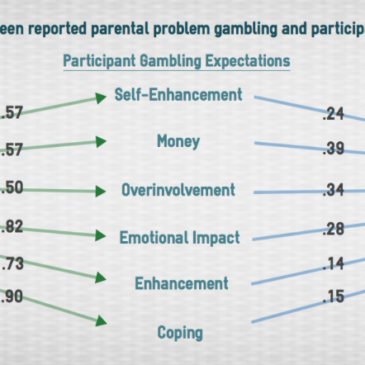Children have a higher chance of developing gambling-related problems if their parents also have gambling-related problems. One explanation for this relationship is that children might observe and mimic their parents’ behavior. This week, the WAGER reviews a study by Nicki Dowling and colleagues that explores how gambling expectations might influence the relationship between parent and child gambling behaviors.
What is the research question?
Does the way a child thinks about gambling relate to the relationship between parent and child gambling-related problems?
What did the researchers do?
The researchers recruited 524 students from universities in Melbourne, Australia. Participants who gambled during the past year were eligible to be included in this study. All participants completed the Problem Gambling Severity Index (PGSI). The researchers assessed parental (i.e., father/male guardian or mother/female guardian) problem gambling using a single question: “To your knowledge, do any of these people have a gambling problem?” Participants reported upon perceived benefits of gambling (i.e., enjoyment/arousal, self-enhancement, money) as well as perceived negative outcomes of gambling (i.e, over-involvement; emotional impacts like guilt, shame, or loss of control). Participants also reported upon their motives to gamble, such as to increase positive emotions (enhancement), to decrease negative emotions (coping), and to meet people (social). The researchers used a mediation analysis to learn how participant gambling expectancies and motivations related to parental gambling-related problems and participant PGSI scores.
What did they find?
Participants who reported a parent with gambling-related problems were nearly 3 times more likely than their peers to report gambling-related problems. This relationship was stronger when participants also reported specific gambling expectations. See Figure 1 for a description of how gambling expectations related to both reported parental problem gambling and participant gambling severity.

Figure. This figure represents a path analysis. Green arrows (left side) represent the relationship between whether a participant indicated that their parents have gambling-related problems and the likelihood that they also reported specific gambling expectations. Blue arrows (right side) represent the relationship between specific gambling expectations and the likelihood that a participant reported gambling-related problems. Note: Numbers represent unstandardized coefficients. All relationships pictured are statistically significant. Click image to enlarge.
Why do these findings matter?
This study suggests that family history holds the potential to guide treatment for gambling-related problems. Individuals who report parental gambling-related problems might benefit from treatment that targets specific expectations about gambling. For instance, during treatment, clients could learn to question their expectations about financial gain from gambling.
Every study has limitations. What were the limitations in this study?
Participants reported their parents’ gambling-related problems. These participants might have given inaccurate reports due to a lack of knowledge of their parents’ experiences or an unwillingness to tell the truth. Similarly, participants reported their parents’ gambling-related problems with a single yes/no answer. Individuals might have different definitions for “gambling problem”. It is unclear how the number of gambling-related problems experienced by a parent relates to participant gambling severity.
For more information:
There’s strength in reaching out. Call or text the National Problem Gambling Helpline at (800) 522-4700 or chat with a counselor online.
— Pat Williams
What do you think? Please use the comment link below to provide feedback on this article.




